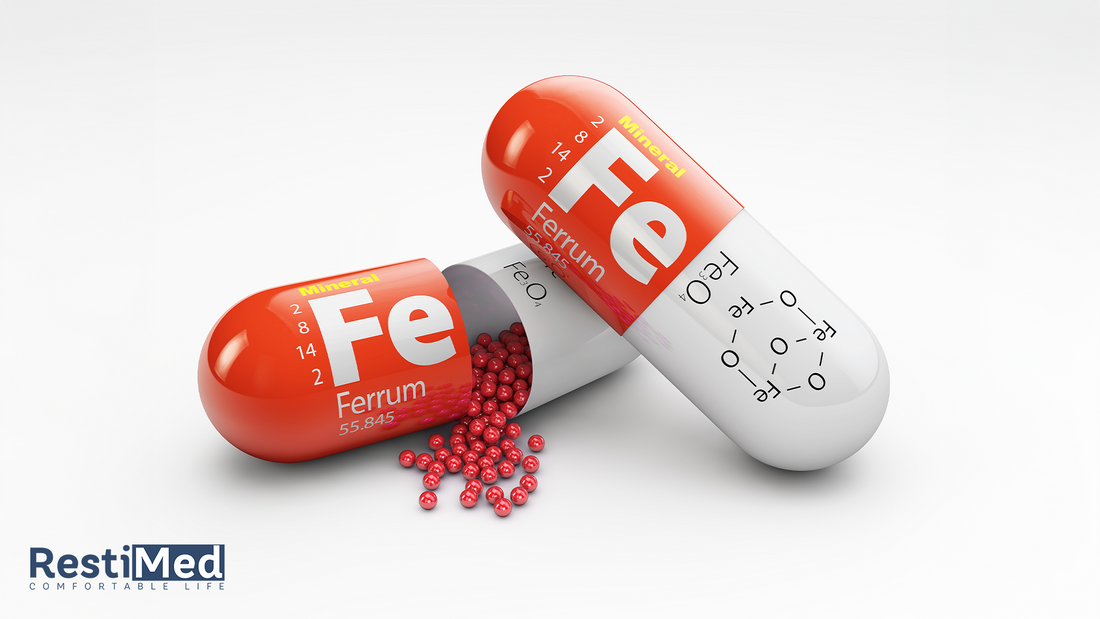
The Link Between Iron Deficiency and Restless Legs Syndrome
Share
Restless Legs Syndrome (RLS) is a neurosensory condition characterized by indescribable restlessness, tingling, and an urge to move the legs, particularly in the evening and at night, significantly affecting sleep and quality of life. The causes of RLS are multifactorial; genetic predisposition, functional differences in the dopaminergic system, and disruptions in brain-iron homeostasis are among the most frequently researched topics. The association between iron deficiency and RLS has been supported by robust scientific data in recent years. Regional iron deficiency in the brain may affect dopamine signaling, predisposing to the emergence of RLS symptoms.
Why Is Iron So Important?
Iron is essential for many neurochemical processes, including dopamine synthesis and receptor function. Individuals with low serum iron may experience not only decreased blood counts but also brain iron , which is associated with an exacerbation of RLS symptoms. Therefore, simply discussing symptoms is not sufficient in individuals with suspected RLS; assessment of iron stores (especially ferritin and transferrin saturation) is recommended. Current clinical approaches emphasize regular monitoring of ferritin and transferrin saturation in the presence of clinically significant RLS .
What Values Should Be Targeted?
Many clinical approaches recommend targeting a ferritin level above 75 µg/L and a transferrin saturation above 20% in the management of RLS. This is because low stores, even at the lower normal range, can trigger RLS symptoms. It's also important to remember that ferritin is an acute-phase reactant and may remain elevated for a period following infection/inflammation. Therefore, interpretation should always be made in conjunction with the clinical presentation.
The Role of Iron Supplementation in Treatment
When iron deficiency is detected, the underlying cause (insufficient intake, blood loss, etc.) must be investigated and corrected. When it comes to iron treatment in RLS, two basic approaches stand out:
- Oral iron: In appropriate patient groups, preparations such as ferrous sulfate may be initiated. It is often recommended to take iron on an empty stomach and with vitamin C to enhance absorption (this varies depending on individual tolerance).
- Intravenous (IV) iron: Options such as IV ferric carboxymaltose may be preferred, especially for patients who cannot tolerate oral therapy, have absorption problems, or desire a faster response. Physicians determine other IV options based on the patient's iron parameters and clinical presentation.
Important note: Iron supplementation should not be initiated haphazardly . Excess iron can be harmful; treatment should be guided by a physician's evaluation and laboratory results.
Lifestyle and Supportive Measures
- Sleep hygiene: Regular bedtimes and wake-up times; a cool, dark, and quiet room; and a goal of 7–9 hours of sleep.
- Limiting triggers: Reducing caffeine, nicotine, and alcohol consumption, especially in the evening.
- Movement breaks: Take a short walk and stretch during periods of prolonged inactivity (flight, meeting, movie, etc.).
- Light to moderate exercise: Regular activity spread throughout the day; avoid intense training until nighttime.
Who Should Be More Careful?
- Women (especially those who lose a lot during menstruation)
- Vegetarian/vegan diets
- Those with gastrointestinal absorption problems or chronic blood loss
- People with pregnancy and chronic diseases
Conclusion
In summary, the iron-dopamine axis plays a crucial role in the biology of Restless Legs Syndrome. Iron deficiency (especially low ferritin and low transferrin saturation) can worsen RLS symptoms; oral or IV iron therapy may be beneficial in appropriate patients. However, each patient's profile is unique, so a physician's examination and laboratory evaluation are essential for a personalized plan.
A Step to Help You Reclaim Your Sleep: Discover Restio
If increased leg rest at night is disrupting your sleep patterns, and you are looking for drug-free, orthopaedic support in your daily routine in addition to a medical evaluation, Restio is designed to help you feel relief from RLS symptoms (results may vary from person to person).
Go to product page →
Note: This content is not medical advice; consult your doctor for diagnosis and treatment.
Source
- American Academy of Sleep Medicine (AASM). Clinical Practice Guideline: Treatment of Restless Legs Syndrome/Willis–Ekbom Disease in Adults.
- Allen RP, Picchietti DL, et al. Evidence-based and consensus clinical practice guidelines for iron treatment of RLS/WED in adults. Sleep Medicine, 2018.
- Silber MH, et al. The Management of Restless Legs Syndrome: An Updated Algorithm. Mayo Clinic Proceedings, 2021.
- Cleveland Clinic. Restless Legs Syndrome (RLS): Causes, Symptoms & Management.
